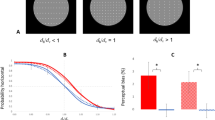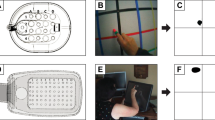Abstract
We describe a compelling demonstration of large-scale developmental reorganization in the human visual pathways. The developmental reorganization was observed in rod monochromats, a rare group of congenitally colorblind individuals who virtually lack cone photoreceptor function. Normal controls had a cortical region, spanning several square centimeters, that responded to signals initiated in the all-cone foveola but was inactive under rod viewing conditions; in rod monochromats this cortical region responded powerfully to rod-initiated signals. The measurements trace a causal pathway that begins with a genetic anomaly that directly influences sensory cells and ultimately results in a substantial central reorganization.
This is a preview of subscription content, access via your institution
Access options
Subscribe to this journal
Receive 12 print issues and online access
$209.00 per year
only $17.42 per issue
Buy this article
- Purchase on Springer Link
- Instant access to full article PDF
Prices may be subject to local taxes which are calculated during checkout







Similar content being viewed by others
References
Østerberg, G. A. Topography of the layer of rods and cones in the human retina. Acta Ophthamol. 6, 1–103 (1935).
Polyak, S. L. The Retina (Univ. of Chicago Press, Chicago, IL, 1941).
Ahnelt, P. K., Kolb, H. & Pflug, R. Identification of a subtype of cone photoreceptor, likely to be blue sensitive, in the human retina. J. Comp. Neurol. 255, 18–34 (1987).
Curcio, C. A., Sloan, K. R., Kalina, R. E. & Hendrickson, A. E. Human photoreceptor topography. J. Comp. Neurol. 292, 497–523 (1990).
Horton, J. C. & Hoyt, W. F. The representation of the visual field in human striate cortex. A revision of the classic Holmes map. Arch. Ophthalmol. 109, 816–824 (1991).
Hadjikhani, N. & Tootell, R. B. Projection of rods and cones within human visual cortex. Hum. Brain Mapp. 9, 55–63 (2000).
Kohl, S. et al. Total color-blindness is caused by mutations in the gene encoding the α-subunit of the cone photoreceptor cGMP-gated cation channel. Nat. Genet. 19, 257–259 (1998).
Kohl, S. et al. Mutations in the CNGB3 gene encoding the β-subunit of the cone photoreceptor cGMP-gated channel are responsible for achromatopsia (ACHM3) linked to chromosome 8q21. Hum. Mol. Genet. 9, 2107–2116 (2000).
Sharpe, L. T., Stockman, A., Jagle, H. & Nathans, J. in Color Vision: From Genes to Perception (eds Gegenfurtner, K. & Sharpe, L. T.) 3–52 (Cambridge Univ. Press, Cambridge, 1999).
Glickstein, M. & Heath, G. G. Receptors in the monochromat eye. Vision Res. 15, 633–636 (1975).
Sharpe, L. T. & Nordby, K. in Night Vision: Basic, Clinical and Applied Aspects (eds Hess, R. F., Sharpe, L.T. & Nordby, K.) 335–389 (Cambridge Univ. Press, Cambridge, 1990).
Weliky, M. & Katz, L. C. Correlational structure of spontaneous neuronal activity in the developing lateral geniculate nucleus in vivo. Science 285, 599–604 (1999).
White, L. E., Coppola, D. M. & Fitzpatrick, D. The contribution of sensory experience to the maturation of orientation selectivity in ferret visual cortex. Nature 411, 1049–1052 (2001).
Gilbert, C. D. & Wiesel, T. N. Receptive field dynamics in adult primary visual cortex. Nature 365, 150–152 (1992).
Kaas, J. H. Plasticity of sensory and motor maps in adult mammals. Annu. Rev. Neurosci. 14, 137–167 (1991).
Heinen, S. J. & Skavenski, A. A. Recovery of visual responses in foveal V1 neurons following bilateral foveal lesions in adult monkey. Exp. Brain Res. 83, 670–674 (1991).
Crair, M. C., Gillespie, D. C. & Stryker, M. P. The role of visual experience in the development of columns in cat visual cortex. Science 279, 566–570 (1998).
Engel, S. A., Glover, G. H. & Wandell, B. A. Retinotopic organization in human visual cortex and the spatial precision of functional MRI. Cereb. Cortex 7, 181–192 (1997).
Kapadia, M. K., Westheimer, G. & Gilbert, C. D. Dynamics of spatial summation in primary visual cortex of alert monkeys. Proc. Natl. Acad. Sci. USA 96, 12073–12078 (1999).
Pettet, M. W. & Gilbert, C. D. Dynamic changes in receptive-field size in cat primary visual cortex. Proc. Natl. Acad. Sci. USA 89, 8366–8370 (1992).
Das, A. & Gilbert, C. D. Topography of contextual modulations mediated by short-range interactions in primary visual cortex. Nature 399, 655–661 (1999).
Kapadia, M., Gilbert, C. & Westheimer, G. A quantitative measure for short-term cortical plasticity in human vision. J. Neurosci. 14, 451–457 (1994).
Andrews, T. J., Halpern, S. D. & Purves, D. Correlated size variations in human visual cortex, lateral geniculate nucleus, and optic tract. J. Neurosci. 17, 2859–2868 (1997).
Rodieck, R. W. Visual pathways. Annu. Rev. Neurosci. 2, 193–225 (1979).
Sharpe, L. T., Collewijn, H. & Nordby, K. Fixation, pursuit and optokinetic nystagmus in a complete achromat. Clin. Vis. Sci. 1, 39–49 (1986).
Sharpe, L. T. & Nordby, K. in Night Vision: Basic, Clinical and Applied Aspects (eds Hess, R. F., Sharpe, L.T. & Nordby, K.) 253–289 (Cambridge Univ. Press, Cambridge, 1990).
Haegerstrom-Portnoy, G., Schneck, M. E., Verdon, W. A. & Hewlett, S. E. Clinical vision characteristics of the congenital achromatopsias. I. Visual acuity, refractive error, and binocular status. Optom. Vis. Sci. 73, 446–456 (1996).
Haegerstrom-Portnoy, G., Schneck, M. E., Verdon, W. A. & Hewlett, S.E. Clinical vision characteristics of the congenital achromatopsias. II. Color vision. Optom. Vis. Sci. 73, 457–465 (1996).
Wandell, B. A. Computational imaging of human visual cortex. Annu. Rev. Neurosci. 22, 145–173 (1999).
Wandell, B. A. Foundations of Vision (Sinauer Press, Sunderland, MA, 1995).
Brainard, D. H. The psychophysics toolbox. Spat. Vis. 10, 433–436 (1997).
Meyer, C. H., Hsu, B. S., Nishimura, D. G. & Macovski, A. Fast spiral coronary artery imaging. Mag. Res. Med. 28, 202–213 (1992).
Ogawa, S. et al. Intrinsic signal changes accompanying sensory stimulation: functional brain mapping with magnetic resonance imaging. Proc. Natl. Acad. Sci. USA 89, 5951–5955 (1992).
Teo, P. C., Sapiro, G. & Wandell, B. A. Creating connected representations of cortical gray matter for functional MRI visualization. IEEE Trans. Med. Imaging 16, 852–863 (1997).
Wandell, B. A., Chial, S. & Backus, B. Visualization and measurement of the cortical surface. J. Cogn. Neurosci. 12, 739–752 (2000).
Acknowledgements
This research was supported by fellowships and grants from the National Institutes of Health (EY30164), National Eye Institute (NEI), North Atlantic Treaty Organization, the Wellcome Trust and the McKnight Foundation. We are grateful to G. Haegerstrom-Portnoy and M. Schneck for referring and providing clinical data on D.G. and S.H. We also thank R. Dougherty, G. Haegerstrom-Portnoy, D. Heeger, S. Heinen, R. Hoffman, V. Koch, W. Newsome, W. Press, M. Schneck and A. Wade.
Author information
Authors and Affiliations
Corresponding author
Ethics declarations
Competing interests
The authors declare no competing financial interests.
Rights and permissions
About this article
Cite this article
Baseler, H., Brewer, A., Sharpe, L. et al. Reorganization of human cortical maps caused by inherited photoreceptor abnormalities. Nat Neurosci 5, 364–370 (2002). https://doi.org/10.1038/nn817
Received:
Accepted:
Published:
Issue Date:
DOI: https://doi.org/10.1038/nn817
This article is cited by
-
Achromatopsie
Die Ophthalmologie (2023)
-
Local neuroplasticity in adult glaucomatous visual cortex
Scientific Reports (2022)
-
Assessing functional reorganization in visual cortex with simulated retinal lesions
Brain Structure and Function (2021)
-
Naturally-occurring myopia and loss of cone function in a sheep model of achromatopsia
Scientific Reports (2020)
-
Determination of scotopic and photopic conventional visual acuity and hyperacuity
Graefe's Archive for Clinical and Experimental Ophthalmology (2020)



